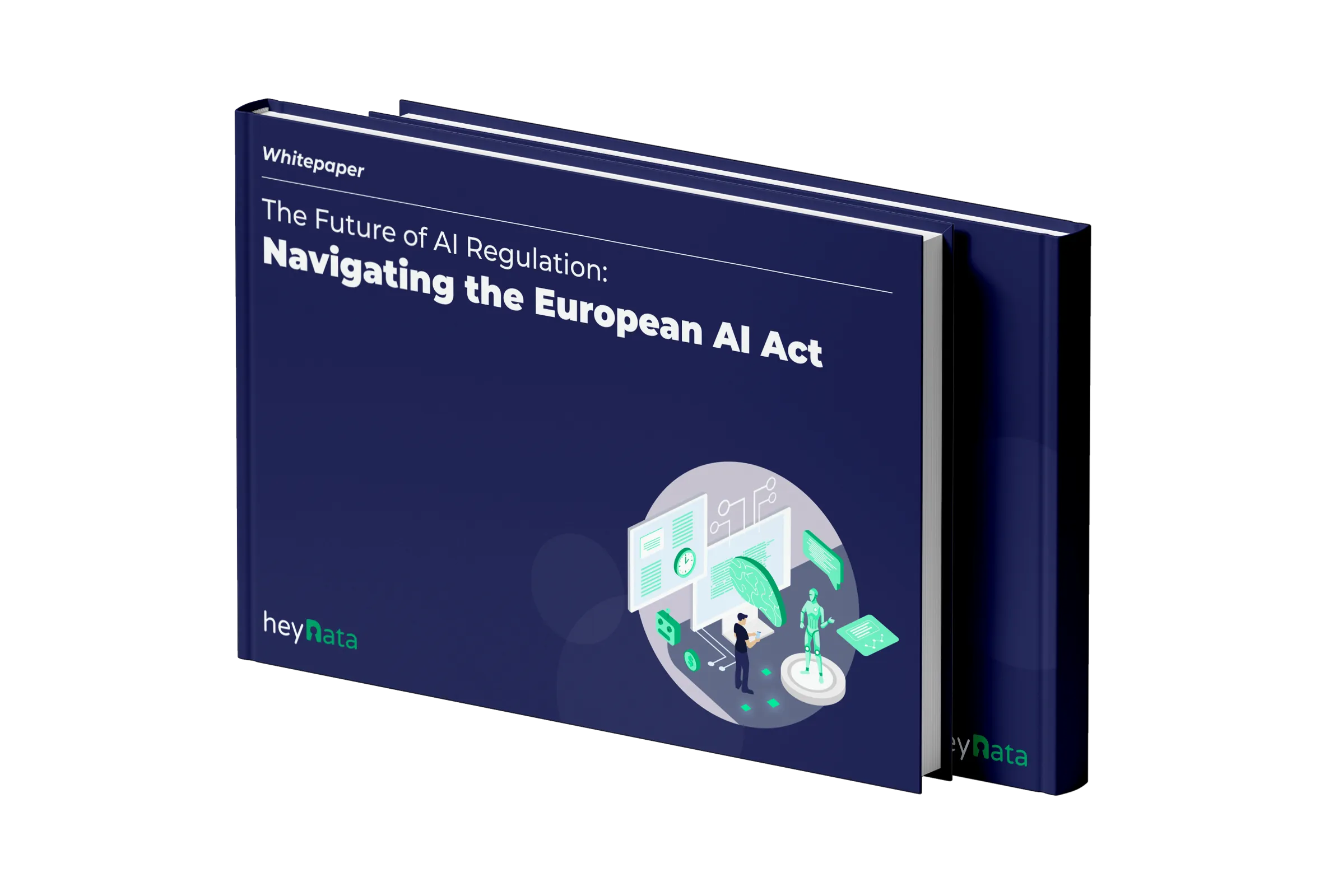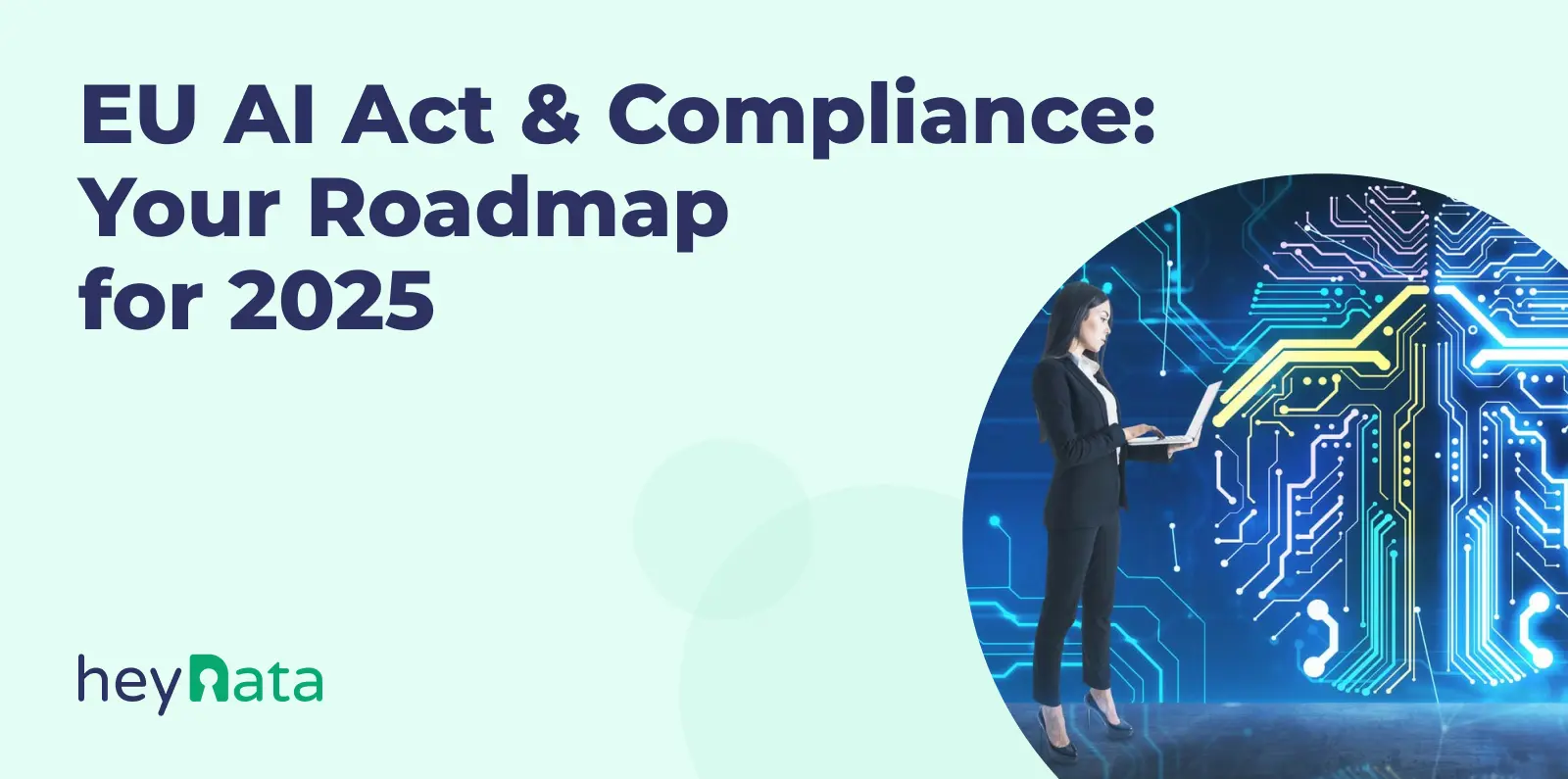
Whitepaper on the EU AI Act

How the EU AI Act Reshapes Compliance: Practical Steps for 2025

'%3e%3cpath%20d='M26.6667%2020.022L30%2023.3553V26.6886H21.6667V36.6886L20%2038.3553L18.3333%2036.6886V26.6886H10V23.3553L13.3333%2020.022V8.35531H11.6667V5.02197H28.3333V8.35531H26.6667V20.022Z'%20fill='%230AA971'/%3e%3c/g%3e%3c/svg%3e) The Most Important Points at a Glance
The Most Important Points at a Glance
- The EU AI Act defines clear rules for the use of AI systems - compliance becomes mandatory starting in 2025.
- Businesses must meet requirements for risk classes, data management, and transparency.
- Documentation, risk analyses, and AI governance will become central compliance topics.
- Real-time monitoring and automated tools, such as those from heyData, simplify demonstrating adherence.
- Early preparation reduces costs, liability risks, and reputational damage.
Introduction
The EU AI Act is the world's first comprehensive AI law. It establishes binding rules for the use of Artificial Intelligence in Europe and impacts almost every business, regardless of its size or industry. 2025 will be the year of implementation. For you, this means compliance becomes a competitive advantage.
But what exactly does this mean for your company? How can you prepare without being suffocated by bureaucracy? And which tools help you meet the new requirements efficiently?
We will clarify these questions in this guide.
Table of Contents:
What is the EU AI Act?
The EU AI Act (Artificial Intelligence Act) establishes uniform, Europe-wide rules for the development, deployment, and monitoring of AI systems. The goal is to promote safe, transparent, and trustworthy AI.
The four risk levels
- Unacceptable Risk: Systems that violate fundamental rights (e.g., social scoring).
- High Risk: AI used in medicine, HR, critical infrastructure, and justice.
- Limited Risk: Chatbots or recommendation systems with transparency obligations.
- Minimal Risk: Spam filters or AI games with no regulatory obligations.
Why the EU AI Act is Changing Everything in 2025
Previously, AI compliance was often voluntary.
Starting in 2025, it becomes mandatory - with high penalties for violations (up to €35 million or 7% of annual turnover).
This primarily affects:
- Companies that develop or integrate AI (e.g., HR tools, chatbots, predictive analytics)
- Organizations that process or provide AI data
- Providers who sell AI products in the EU market
The EU AI Act thus interferes in areas such as data protection, product safety, risk management, and ethics: extending far beyond classic IT compliance.
Concrete Obligations for Businesses
a) Risk Classification
Identify all AI systems in use and categorize them according to their associated risk levels.
Practical Example: HR software that pre-sorts applications is considered “High Risk.”
b) Data and Documentation Obligation
Companies must be able to prove that training data is:
- Fair, representative, and free of discrimination
- Securely stored and processed in a traceable manner
c) Governance and Responsibilities
An internal AI compliance framework is mandatory.
This includes roles, approval processes, internal audits, and reporting obligations.
d) Technical Monitoring
Ongoing review of AI models for bias, performance, and security.
Automated monitoring tools are helpful here.
With heyData, you can centralize compliance processes, automatically create audit documentation, and track changes in EU law in real time.

Whitepaper on the EU AI Act
Practical Steps for Implementation
| Phase | Measure | Goal |
|---|---|---|
| 1. Analysis | Inventory AI systems and classify risk | Create an overview |
| 2. Strategy | Define governance framework and responsibilities | Clear responsibilities |
| 3. Implementation | Policies, monitoring tools, documentation | Ensure compliance |
| 4. Automation | Use AI-powered solutions (e.g., heyData) | Make processes efficient |
| 5. Training | Sensitize employees | Strengthen compliance culture |
Common Mistakes and How to Avoid Them
- Missing inventory: Many do not even know where all AI is being used.
- Unclear responsibilities: Without responsible persons, every compliance effort fails.
- One-time check instead of continuous process: The EU AI Act requires ongoing monitoring.
- Lack of transparency: Users must know when they are interacting with AI.
Continuous Compliance with AI Automation
Instead of annual audits, Continuous Compliance is prevailing.
Tools analyze in real time whether policies are being adhered to and automatically document deviations.
Looking Ahead: 2025 and Beyond
The EU AI Act will only be the beginning.
Further adaptations to data protection (GDPR 2.0), NIS2, and CSRD are already in the works.
Those who invest now lay the foundation for a future-proof compliance structure.
Conclusion
The EU AI Act forces businesses to review their AI processes critically.
However, those who act now benefit in two ways: legal certainty and trust.
With automated solutions like heyData, you can not only meet these requirements but also use them strategically.
FAQs zum EU AI Act
What is the EU AI Act?
The EU AI Act is the first EU-wide law that establishes rules for the safe use of AI.
When does the EU AI Act come into force?
The transition phase runs until mid-2025, after which violations are subject to fines.
Who is affected?
All companies that develop, operate, or use AI systems—regardless of size.
What are the most important obligations?
Risk assessment, documentation, governance, monitoring, and transparency towards users.
How can heyData help?
heyData offers compliance automation, documentation, audits, and training tools for implementing the EU AI Act.
Important: The content of this article is for informational purposes only and does not constitute legal advice. The information provided here is no substitute for personalized legal advice from a data protection officer or an attorney. We do not guarantee that the information provided is up to date, complete, or accurate. Any actions taken on the basis of the information contained in this article are at your own risk. We recommend that you always consult a data protection officer or an attorney with any legal questions or problems.


